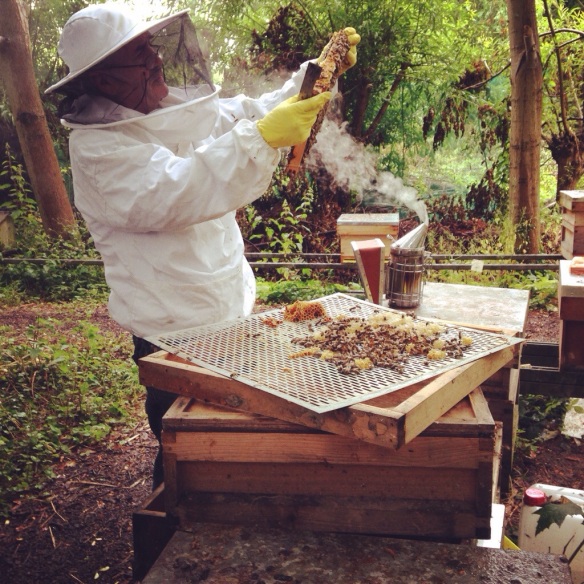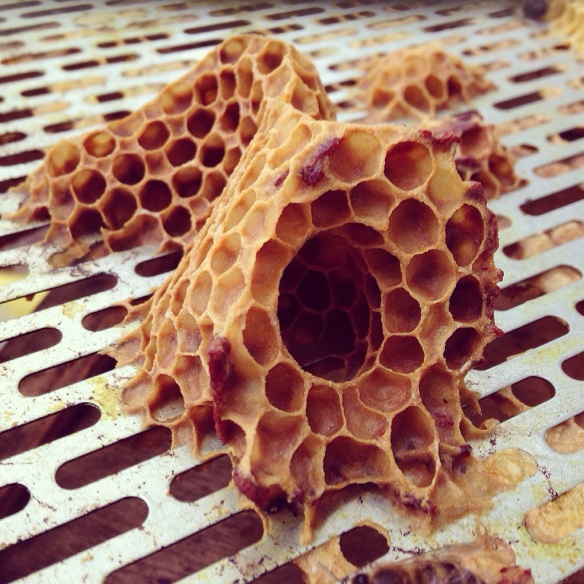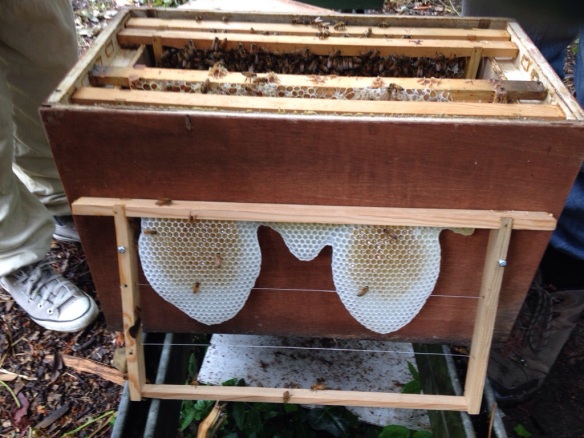Some say the beekeeper’s year starts in late August to early September after the honey has been harvested and the bees are preparing for winter. In July the flow of nectar should be generous and foragers seen flying home with heavy loads of pollen.
So on Saturday 28 June I stood in front of our hives appreciating that we are on a tight schedule. After getting the bees going in spring, there is a narrow window during which the colony must be strong and conditions must be right to produce a super of honey.
Emily and I have missed that window for the past two years contending with rain, failed queens and small swarmy colonies, but this year our hopes are pinned on two supers on Myrtle’s hive.
With five hives we can’t yet claim the honey as ours. Good weather and strong queens are needed for the bees to make enough stores to see all colonies through winter and to give us a harvest.
Today we wouldn’t tell if the bees were on track. We were rained out and though some beekeepers did open their hives, they were met with a roar from the bees. Albert’s artistic ladies had been playing in the roof making a construction worthy of Tate Modern.
Thomas’s Italian ‘teddy bear’ bees were remarkably calm despite the rain and nursing queen cells. The nuc with the old queen had been experimenting with natural comb. Thomas explained that they start by building two oval segments on either side of the frame before joining them up.
The rain was falling thick and fast now, so we gave up for the day. On my way home I reflected so much time is spent wishing for honey, we forget that the bees are doing something even more amazing all the time – building honeycomb.
I’ve blogged about the wonder of honeycomb before, but it’s worth repeating.
The honeybee builds honeycomb from wax secreted by the abdominal glands, which is passed along the legs to the mouth and moulded into hexagonal cells. She builds row upon row of perfect six-sided cells in a precise hexagonal array.
Marcus du Sautoy gives a lovely explanation of why bees choose hexagons to build their comb on BBC’s ‘The Code’. “The bees’ primary need is to store as much honey as they can, while using as little precious wax as possible.” To produce a regular-shaped interlocking network, bees can choose three shapes: triangles, squares or hexagons. A hexagon requires the least amount of wax to build and stores the highest volume of honey, which makes it the most efficient shape. “It is a solution that was only mathematically proven a few years ago. The hexagonal array is the most efficient storage solution the bees could have chosen,” says Marcus. “Yet with a little help from evolution they worked it out for themselves millions of years ago.”
Rain or shine we will get wax from our bees, and watching this brings a new appreciation for candles.






Reblogged this on Linda's wildlife garden and commented:
Awesome update thank you for posting have a blessed evening
We have also wary of collecting honey yet and had two poor years before this. The mild weather has been a good thing for them though.
Me too. I waited till my first hive had three supers before taking away two. They then made another and I left them two for winter. If things continue well Emily and I will have a super though – yay!
Re Tate Modern – it’s the sculpture Anish Kapoor should have got round to but never has…
Bees are so clever. They were climbing up and down the tunnel for apparently no reason, it didn’t lead anywhere, it’s not the shape of natural honeycomb nests, and it can’t be used for practical reasons for brood and honey. I’ve seen this behaviour before when they build incredible extraneous structures and climb all over them – bee play.
Maths in nature, love it. And the bees figured it out before we did! 🙂
Bee math is amazing! What’s more, I also found out recently that hexagon arrays are known as P6 (six-fold symmetry) which in crystallography is one of the 17 symmetries allowed in two dimensions. There’s a great story about 17 symmetries used in an Islamic palace, Alhambra, by Islamic architects but honeybees had it all figured out in their hives and knew hexagons were best.
They are wonderful creatures. I didn’t know the link to crystallography – fascinating, thank you! a lot of ancient architects based their designs on natural geometry – but people were more connected with Nature then 🙂
So many new bee keepers around here take honey regardless and then spend weeks feeding in the fall. I’m planning to leave most or all of the honey and wait until next year and see if they have any to spare then. Honeycomb really is amazing, isn’t it!
Yes, I think people sometimes forget some of the crop might also be needed for overwintering. Honeycomb is one of nature’s wonders.
Beautiful photos. I enjoy your blog.
Thanks!
Thank you!
I like the photo of the bee mooning you. It is just darling. Right now, I am happy for the rain we have been getting. I still wish it was a bit more as we have years of drought to catch up on for the trees. Bees have been active this year too because of more nectar I think.
That’s what I thought! Sorry for late reply – work exhibition and furious cold, so catching up. I’d happily swap half our rain for your sunshine 🙂